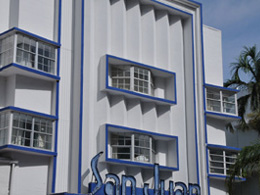COLUMNS
360º Architecture
On 23 January 1931, the ball of the Society of Beaux-Arts Architects was staged in the Large Ballroom, on the ninth-floor of the Beaux-Arts Hotel Astor, in the heart of New York's Times Square. The twelfth themed Beaux-Arts ball was the first of these annual high-society events that looked forward rather than backward. Since the first costume ball of 1914, on the theme of 'Venice Through the Ages', Beaux-Arts ball themes had included, among others, 'A Pageant of Ancient France', 'The Gardens of Versailles', 'Napoleon' and a Renaissance spectacle that followed the 1929 stock market crash, in 1930. For the 1931 'Fête Moderne - a Fantasie in Flame and Silver', the Louis XV white-and-gold features of Astor's grand ballroom were blackened out, and the Beaux-Arts architects and artists of New York were invited to probe the 'Spirit of the Age' against a backdrop of flaming red and silver. At the depth of the Great Depression, the ball's organizers warned that 'the modern spirit in art is not a new recipe for designing buildings, sculpture and painted decoration but is a quest for something more characteristic and more vital as an expression of modern activity and thought...In the decoration, as in the costumes, the effect sought is a rhythmic, vibrant quality expressive of the feverish activity which characterizes our work and our play, our shop windows and our advertisements, the froth and the jazz of modern life.'(1) In the days before the ball, several newspapers published advertisements promising a feast that would be 'modernistic, futuristic, cubistic, altruistic, mystic, architistic and feministic.' Its now famous highlight was the tableau vivant Skyline of New York, a ballet presented by at least two dozen architects dressed as buildings they had designed. William van Alen outshone them all with his Chrysler costume, made of silver metal cloth, flame-coloured silk, patent leather and the same exotic woods used in his mid-Manhattan iconic skyscraper. The first-floor elevator doors decorated his cape, the sixty-first-floor gargoyle eagles were refashioned as epaulettes, and the Chrysler's beacon towered on his head.
More than four decades later, Rem Koolhaas would interpret the 1931 Beaux-Arts extravaganza, in his book Delirious New York, as 'Manhattan's counterpart of the CIAM Congress on the other side of the Atlantic: a delirious grope after the Spirit of the Age and its implications for the increasingly megalomaniac profession'.(2) Indeed, New York's zoning laws of 1916, which by 1929 had been adopted by over one hundred North American cities, had given rise to a style then called 'modern', 'modernistic' - a disparaging term - or 'moderne' - a reference to its Parisian beginnings - and since the sixties known as Art Deco, whose exponents and admirers professed that 'economy and efficiency are not, after all, everything, so to significant, dramatic, organic, let us add ecstatic, with this for an over-word: "Wake up and dream".'(3)
Even though this twentieth-century modern, but not Modernist, highly-popular style came to be known by a name derived from the hugely influential 1925 Exposition internationale des arts décoratifs et industriels modernes, in Paris (in which the United States did not participate), it is not without reason that its defining characteristics, ambitions and aspirations, fed by commercial interests, the spread of capitalism, advertising and mass consumption, came to be associated with a typically North American sensibility. Especially its late, Jazz Moderne, ZigZag Moderne or Streamlined Moderne variants are seen to represent an American-inspired modernity and core American values. At a time of dramatic technological and social change, Art Deco found exceptionally fertile ground in the US, and literally exploded from Manhattan's iconic skyline to eye-catching posters and packaging, illuminated shop-window displays and mass-produced streamlined consumer goods. It quickly became the defining style of American business culture in the interwar years, enjoying a spectacular mass-market appeal that shaped US tastes and fashions to a degree nowhere near anything achieved by its earlier, European or Europeanized, more exclusive variant, to a large extent confined to a world of luxury, a social and economic elite and a specialist public.
The phenomenal spread of the style's popularity in America, its pragmatic vision and unhesitant engagement with the commercial world - which exploited Art Deco's prioritization of visual appeal and maximized its powers of seduction - its desire for individuality and novelty, but not revolution, its formal eclecticism and openness to influence, its lack of prescriptive theory and overt ideology, defined an undogmatic modern style in a complementary relationship with, if not in rivalry and opposition to, its contemporary, socially-engaged, ascetic and didactic high Modernism. Koolhaas's reading of the 1931 gathering of the authors of New York's Art Deco landmarks as 'Manhattan's counterpart of the CIAM Congress on the other side of the Atlantic' echoed contemporary sneering at American commercial moderne and 'anti-social' Art Deco, unashamedly decorative and showy, professedly and self-consciously popular, excess-loving and indulgently frivolous, in striking contrast with the austere, high-brow forms of ambitious avant-garde, doctrinaire and utopian Modernism. Koolhaas pronounced the Empire State Building, 'the last manifestation of Manhattanism...a form of automatic architecture' - an ironic reference to the European avant-garde's experiments with automatic writing - 'a sensuous surrender by its collective makers - from the accountant to the plumber - to the process of building...[It is] a building with no other program than to make a financial abstraction concrete...[a building with] no content...sheer envelope.'(4)
In the 1920s and 1930s, in England, 'the Architectural Review waged successive campaigns against commercialism in the form of advertising hoardings, Art Deco factories and cinemas and other forms of "bad taste"...Establishment architects resisted Art Deco ornamentation as showy, disruptive and "foreign".'(5) Infuriated by England's latest Art Deco factories and cinemas, obedient to the laws of the marketplace, in 1927, the President of the Royal Institute of the British Architects, Hubert Worthington, expressed his preference for a modern architecture which is 'logical, harmonious and well composed...well planned and well constructed and co-operative and English...sane, masculine and unaffected and human, and imbued with the quality of the eternal', all qualities that he saw lacking in the Manhattan-inspired architecture.(6) Unsurprisingly, Denise Scott Brown and Robert Venturi were among the early supporters of a re-assessment of Art Deco architecture and its values, and champions of the conservation of Art Deco buildings in New York and Miami Beach.
While avant-garde European architects moved increasingly towards a purist, functionalist Modernism, the American architectural elite represented by New York's Museum of Modern Art (MoMA) rejected streamlining and embraced the International Style, and European critics damned the Art Deco 'anti-social', self-advertising and ephemeral aesthetic as 'bad taste', attention-seeking high-street shops, petrol stations, factory-built diners and fabulously decorated cinemas, throughout the US, spread the style's popularity to a mass audience. The roadside diners that populated the country in the 1930s were the creation of anonymous designers, employing all the new industrial materials - stainless steel, glass blocks, Formica laminates, linoleum, Fabrikoid artificial leather and chromed steel - and were industrially produced. They are Art Deco's true vernacular expression of its aesthetic principles. Ironically, in these popular diners, 'the new materials of machine-age technology attained a state of decorative expression that approached the Modernist ideal of truth to materials,'(7) and the long-cherished dream of Walter Gropius and Le Corbusier for a factory-made, mass-produced, low-cost building became a reality.
Even though European cinema in the 1920s had also featured Art Deco sets and costumes as symbols of modernity (the French architect Robert Mallet-Stevens was responsible for some of the most impressive examples), in the 1920s and even more forcefully in the 1930s, the Hollywood 'dream factory' did more than any other medium to establish Art Deco as a mass style and as the style that represented American culture, through irresistible tales of luxury, travel and glamour, upward mobility, individualism and consumerism, youth, beauty and sexual liberation.(8) Aided by Hollywood, but also by the development of new technology and materials, especially metal alloys and plastics, the new discipline of industrial design, the transport revolution, and the industrialization of production, publicity and consumption, Art Deco in America achieved emancipation from historicist styles, and developed at a distance from European ideas of modernity and state-led modernization, despite the significant contribution of European émigrés.
Rather than castigated for its frivolity and 'anti-social' pursuit of pleasure and luxury, in Depression and New Deal America, Art Deco was mobilized to help the economy exit the recession by boosting commercial competition and consumerism, through mass advertising and the 'new merchandising device' of 'styling the goods', that is, by employing industrial design as a method to achieve stylistic obsolescence and, thus, to 'streamline the sales curve'.(9) Streamlining was one of the favourite techniques. Distinctly American in its applications beyond its original domain of hydrodynamics and aeroplane, ship, automobile and locomotive engineering - from the design of buildings and furniture to that of cars, refrigerators, cocktail shakers and cigarette lighters - and much popularized by Norman Bel Geddes's book Horizons (1932), streamlining became synonymous with horizontal, sweeping lines, smooth surfaces and rounded corners, symbolizing energy, speed, efficiency, dynamism, science and rationality. Transatlantic ocean liners, trains, buses, cars and aircraft acquired streamlined exteriors as well as interiors, connoting not only speed but, even more importantly, glamour and luxury, elegance and comfort.(10) Their lavishly decorated interiors, especially those of the immensely popular, architects' all-time favourite, the stylish ocean liner, were exhaustively mined as sources of a resonant modern and cosmopolitan imagery, combined with nautical allusions such as curved ship hulls, imposing funnels, porthole windows, projecting decks and captain's bridges.
Tourist agencies, vehicle manufacturers and holiday resorts promoted the image of travel as a symbol of modernity, and streamlining enhanced the visual appeal as well as the message of their campaigns. Travel, leisure and entertainment had become deeply enmeshed in North American consumer culture. A product of industrial capitalism and a growing prosperity for the majority, American hotels in the interwar years catered to the needs and aspirations of the rising middle and upper-middle classes. The increasingly commercialized and industrialized pursuit of leisure and entertainment, pleasure and hedonism was reflected in the hotel architecture of popular seaside resorts like Miami Beach, Florida, with its impressively high concentration of Art Deco buildings, the country's first twentieth-century architectural district to be placed on the National Register of Historic Places. Following a spectacular building boom, Miami Beach was devastated by the hurricane of late 1926, closely followed by the Great Depression. But by the mid-1930s construction activity in America's 'paradise under the sun' was on the increase, reaching a peak in 1939 and 1940. From 1935 to 1940, two hundred mostly small hotels were built, largely clustered in South Beach. In February 1940, Time declared that Miami Beach was 'a booming catholic pleasure dome...like no other city in the U.S., or in the World.'(11)
It did not escape Koolhaas that 'in the thirties...the "Hotel" becomes Hollywood's favorite subject'.(12) Luxury hotel lobbies and ocean liners - themselves floating luxury hotels - extravagant penthouse apartments and permissive nightclubs, all in meticulously detailed Art Deco style, provided the perfect Hollywood settings for the fantasy of modern life. Miami Beach aggressively promoted similar fantasies of escape, fun and freedom, and not only for the wealthy winter vacationers from the north. An advertisement in Vanity Fair promised 'a utopia of pleasure and health...for the wallet-weary.'(13) Miami's hotel developers and their architects found in Art Deco, mostly its jazz moderne and streamline moderne variant, a style that was flexible enough to accommodate tropically inspired imagery and exotic romance, together with evocations of internationalism and the spirit of the machine age.
As Tim Benton points out, 'streamlining allowed designers to reinvent the decorative without recourse to ornament.'(14) It also enabled them to create seductive compositions that exuded optimism and signified modernity, while remaining within an austerity budget, and highlighting occasional touches of Depression-era glamour. The architects who dominated the scene were Henry Hohauser, Igor Polevitzky, Albert Anis and Lawrence Murray Dixon. Dixon was the most prolific of all architects practising in Miami Beach in the 1930s and 1940s, and a native of Florida who had started his career working for Schultze and Weaver, the architectural firm famous for designing the new Waldorf-Astoria Hotel (1929-31) - the Art Deco 'unofficial palace of New York' that became a landmark in the history of the American hotel - as well as the Biltmore in Coral Gables (1928-29) and the Breakers in Palm Beach, Florida (1925-26). Intellectually undemanding but nevertheless novel and eminently endearing, free of theoretical constraints and limitations, indifferent to the castrating moralism and earnest functionalist rhetoric of contemporary Modernism, and devoted to the epicurean pursuit of pleasure, the Art Deco hotels of Miami Beach, together with other local residential, entertainment and retail buildings serving their growing leisured and exclusively white clientele, and sharing the same aesthetic principles, constitute a popular architectural manifesto of commercial, consumer-centred modernity.(15)
Their design methods and principles as well as their aesthetic choices are close to those of product styling developed by Depression-era industrial designers, who targeted a wide public and an increasingly democratized consumer market. Their ship and automobile inspired aesthetics introduced to the spirit of the machine age an audience far larger than that courted by the Corbusian villas of the previous decade, in the exclusive suburbs of Paris. Having made a short stop in Miami, on his way from Bogotá to New York, in September 1950, Le Corbusier noted his disapproval of both: 'New York/Miami: neither of them very reassuring.' And on another page of his sketchbook, he listed the names of Miami architects and commented: 'all great guys, ardent, ideal, professional qualities. Very much artists, consider me to be the leader of modern architecture. Build very honestly but eccentricities for rich people. Social relevance is not at stake here.' At the foot of New York's Brooklyn Bridge, the next day, he wrote: 'Yesterday, it was Miami with the luxuries of villas, green spaces, trees budding, flowers blooming, avenues and automobiles. Enough to make one utterly sick from so much artifice. The true is here, on the Piers of South Street.'(16) In fact, Le Corbusier had designed a number of villas in the 1920s, in Paris, for influential American clients, far wealthier than the customers of Miami's resort architecture.(17)
Commissioned by Miami Beach's hotel developers and aiming to stimulate popular fantasy, Art Deco architects adopted vibrant silhouettes, cubic massing and clean lines; strategically employed pastel colours and applied decoration such as friezes, bas reliefs with tropical motifs and fluting or ornamental stone cladding; attention-grabbing concrete accordion walls and protrusions such as towers, flagpoles, spires, pylons, signage finials and boat-inspired stacks; projecting concrete entrance porticos and wrapping eyebrows, ribbon windows, corner windows and portholes; glass-block and etched-glass panels; skyscraper-inspired stepped profiles and angular jaunts; integrated architectural lettering; and outdoor terraces. Gleaming metals and popular new materials such as Vitrolite, a substitute for marble, were both economic and in the spirit and letter of the machine-age. Contoured forms, incised racing or zigzagging stripes and rounded corners, the hallmarks of the Streamlined Decade, echoed the forms of the latest fashion in plastic consumer goods such as radios, whose functional curvilinear forms facilitated the moulding process.
Miami's charming hotels sported sophisticatedly detailed and elegantly furnished lobbies, presented as the city's new public spaces but accessible to whites only, modelled on Rockefeller Center's Radio City Music Hall and becoming grander as Miami's economic outlook improved. They featured colourful terrazzo floors, murals depicting Florida's flora and fauna, staircases and mezzanines with decorative metalwork, decorated elevators and ziggurat-shaped, marble or Vitrolite-clad fireplaces, obviously only as a metaphor of luxury and comfort. Fluorescent and neon lighting for lettering and graphic delineation of building features, and lighting troughs that concealed coloured-light sources became innovative façade- as well as street-composition elements, advertising a twenty-four-hour winter resort where the spectacle of the good life never expires.
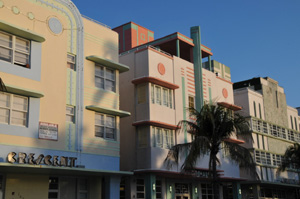
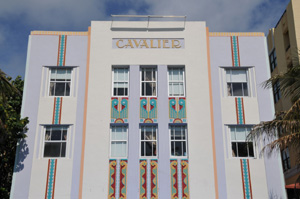
Hotels Crescent (Henry Hohauser, 1938), McAlpin (Lawrence Murray Dixon, 1940), and Ocean Plaza (Lawrence Murray Dixon, 1941), left; and Hotel Cavalier (Roy France, 1936), right. South Beach, City of Miami Beach, Florida. Photographs by Styliane Philippou
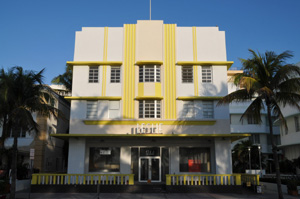
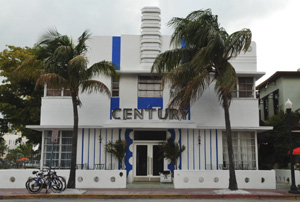
Hotel Leslie (Albert Anis, 1937), left; and Hotel Century (Henry Hohauser, 1939), right. South Beach, City of Miami Beach, Florida. Photographs by Styliane Philippou
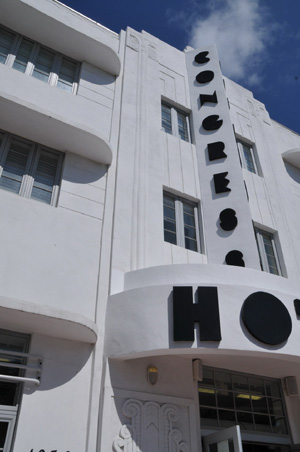
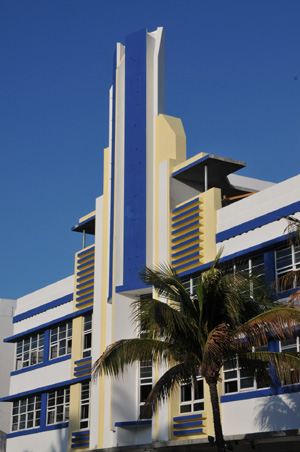
Hotel Congress (Henry Hohauser, 1936), left; and Hotel Breakwater (Anton Skislewicz, 1939), right. South Beach, City of Miami Beach, Florida. Photographs by Styliane Philippou
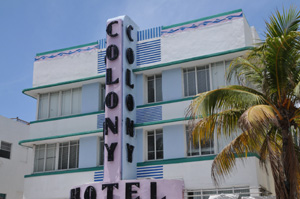
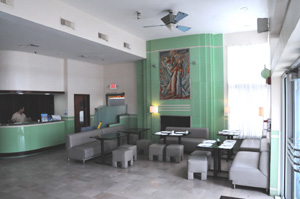
Hotel Colony (Henry Hohauser, 1935) with lobby clad in lime-green Vitrolite panels. South Beach, City of Miami Beach, Florida. Photographs by Styliane Philippou
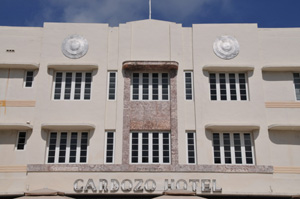
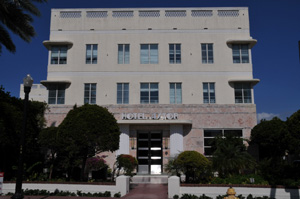
Hotel Cardozo (Henry Hohauser, 1939), left; and Hotel Astor (T. Hunter Henderson, 1936), right. South Beach, City of Miami Beach, Florida. Photographs by Styliane Philippou

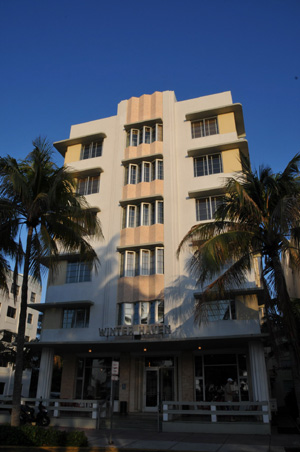
Hotel Park Central (Henry Hohauser, 1937), left; and Hotel Winterhaven, (Albert Anis, 1939), right. South Beach, City of Miami Beach, Florida. Photographs by Styliane Philippou
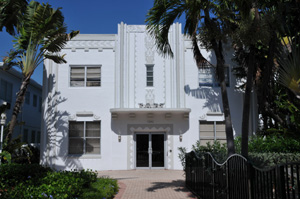
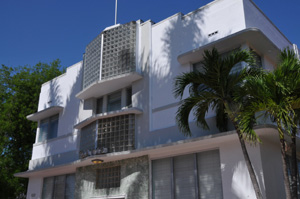
Hotel Taft (Henry Hohauser, 1936), left; and Hotel Davis (Henry Hohauser, 1941), right. South Beach, City of Miami Beach, Florida. Photographs by Styliane Philippou
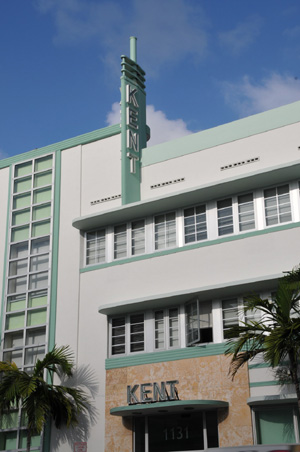
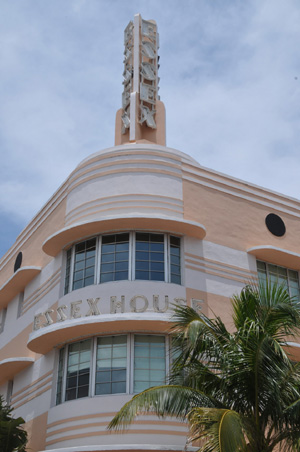
Hotel Kent (Lawrence Murray Dixon, 1939), left; and Hotel Essex House (Henry Hohauser, 1938), right. South Beach, City of Miami Beach, Florida. Photographs by Styliane Philippou
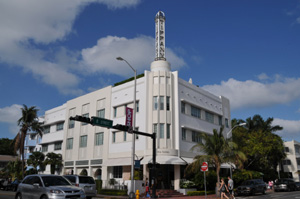
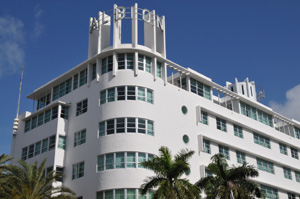
Hotel The Tiffany (Lawrence Murray Dixon, 1939), left; and Hotel Albion (Polevitzky and Russell, 1939), right. South Beach, City of Miami Beach, Florida. Photographs by Styliane Philippou
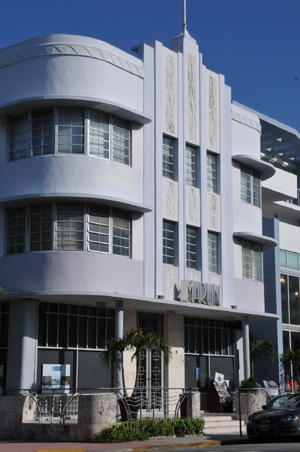
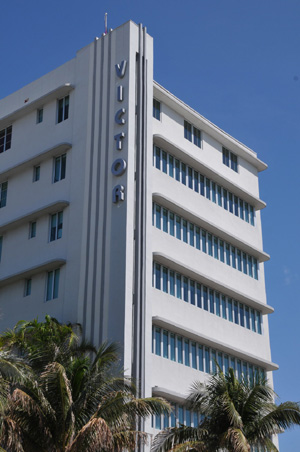
Hotel Marlin (Lawrence Murray Dixon, 1939), left; and Hotel Victor (Lawrence Murray Dixon, 1937), right. South Beach, City of Miami Beach, Florida. Photographs by Styliane Philippou
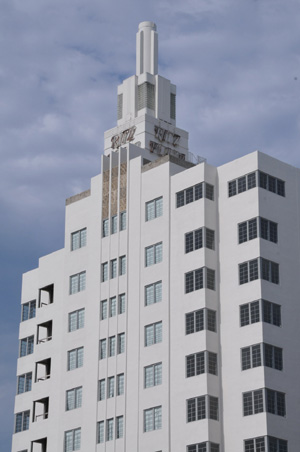
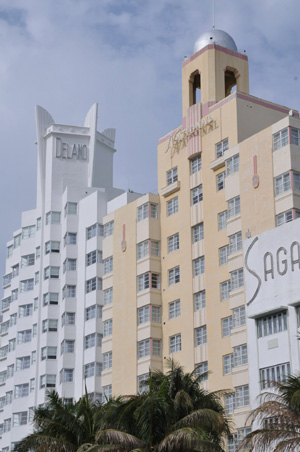
Hotel Ritz Plaza (Lawrence Murray Dixon, 1940), left; Hotel Delano (Robert Swartburg, 1947) and Hotel National (Roy France, 1940), right. South Beach, City of Miami Beach, Florida. Photographs by Styliane Philippou
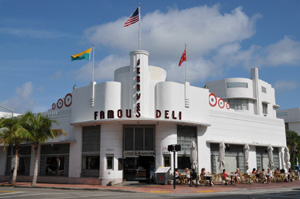
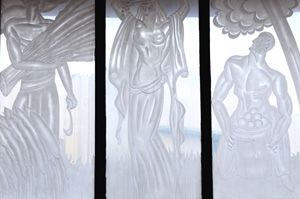
Hoffman's Cafeteria (Henry Hohauser, 1940), South Beach, City of Miami Beach, Florida. Photographs by Styliane Philippou
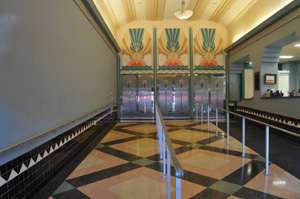
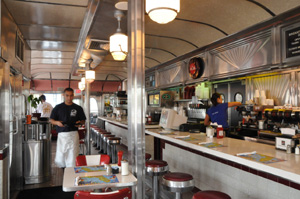
Colony Theatre, lobby, left; and 11th Street Diner, right, South Beach, City of Miami Beach, Florida. Τhe stainless steel diner, this quintessentially North American popular Art Deco structure was imported from Pennsylvania, following Miami's re-appreciation of its Art Deco heritage, and redevelopment, in 1992. It was originally fabricated in Haledon, N.J., and assembled at Wilkes Barre, Pa., in 1949. Photographs by Styliane Philippou
Notes
1 'Fête Moderne - a Fantasie in Flame and Silver', programme for the Beaux-Arts ball of 1931. Quoted in Koolhaas, Rem, 1994, Delirious New York (New York: The Monacelli Press, first edition 1978), p. 126.
2 Koolhaas, p. 127.
3 Claude Bragdon, 1932, emphasis in the original. Quoted in Benton, Tim, 2003, 'Art Deco Architecture'. In Benton, Charlotte, Tim Benton and Ghislaine Wood (eds), Art Deco 1910-1939 (London: V&A), exhibition catalogue, p. 251. On the naming of Art Deco, long after its demise, in the 1960s, and on the style's various definitions, see Benton, Charlotte and Tim Benton, 2003, 'The Style and the Age'. In Benton, Charlotte et al (eds), pp. 13-27.
4 Koolhaas, pp. 138-41, emphasis in the original.
5 Benton, Tim, p. 256.
6 Quoted in Benton, Tim, p. 256.
7 Meikle, Jeffrey L., 2003, 'New Materials and Technologies'. In Benton et al (eds), p. 358.
8 See Wood, Ghislaine, 2003, 'Art Deco and Hollywood Film'. In Benton et al (eds), pp. 325-33.
9 Designer Raymond Loewy was hailed on the cover of Time as the man who 'streamlines the sales curve'. Weston, Richard, 1996, Modernism (London: Phaidon), p. 195. See also Maffei, Nicolas P., 2003, 'The Search for an American Design Aesthetic: From Art Deco to Streamlining'. In Benton et al (eds), p. 364.
10 As Paul Atterbury explains, in fact, streamlining of means of transport 'had only a limited effect upon the speed achieved.' For example, 'faster timings were regularly achieved by unstreamlined trains in European countries...In the field of popular motoring, [too,] streamlining was more about style than performance'. Atterbury, Paul, 2003, 'Travel, Transport and Art Deco'. In Benton et al (eds), pp. 315-23.
11 Quoted in Curtis, James R., 1995, 'Art Deco Architecture in Miami Beach. In Carney, George O. (ed.), Fast Food, Stock Cars, and Rock-n-Roll: Place and Space in American Pop Culture (London: Rowman and Littlefield), p. 193. See also Lejeune, Jean-François and Allan T. Shulman, 2000, The Making of Miami Beach, 1933-1942: The Architecture of Lawrence Murray Dixon (Miami Beach, Florida: Bass Museum of Art), exhibition catalogue.
12 Koolhaas, p. 148.
13 Quoted in Curtis, James R., p. 193.
14 Benton, Charlotte and Tim Benton, p. 27.
15 Local social inequities were concealed to tourist eyes. An exception, Bobbi Graff from Detroit, described Miami's strange world when she arrived in 1946: 'To the tourist, it was a fantasy land. But it was also a growing metropolis where segregation, discrimination and blatant racist terror were the law. To be a concerned human being was a challenge.' Quoted in Read, Gray, 2009, 'Many Miamis: The Theatre of Public Space'. In Shulman, Alan T. (ed.), Miami Modern Metropolis: Paradise and Paradox in Midcentury Architecture and Planning (Miami Beach, Florida: Bass Museum of Art and Glendale, California: Balcony Press), exhibition catalogue, p. 64.
16 Quoted in Lejeune, Jean-François, 2009, 'City Without Memory: Planning the Spectacle of Greater Miami'. In Shulman, Alan T. (ed.), p. 35.
17 See Bacon, Mardges, 2001, Le Corbusier in America: Travels in the Land of the Timid (Cambridge, Massachusetts: MIT Press), pp. 4ff.
Related articles:
- 360 Degrees Architecture ( 10 October, 2009 )
- Τhe Roots of the Industry of the Image ( 27 October, 2009 )
- Anish Kapoor: Non-objective Objects ( 26 November, 2009 )
- Love Thy Planet ( 28 December, 2009 )
- Europe’s Civilization under Threat ( 28 January, 2010 )
- Made of Stone and Water, for the Human Body ( 28 February, 2010 )
- Bokja: ‘A Woman’s Affair’ ( 28 March, 2010 )
- Brasília from the Beginning, Fifty Years Ago ( 07 April, 2010 )
- Brasília, ‘capital of the highways and skyways’ ( 30 April, 2010 )
- Oscar Niemeyer’s Permanent International Fair in Tripoli ( 29 May, 2010 )
- The Greatest Show on the Beach ( 08 August, 2010 )
- Oscar Niemeyer: Curves of Irreverence ( 28 March, 2011 )
- The Lizards of Djenné ( 26 September, 2010 )
- Transformed by Couture ( 29 October, 2010 )
- Another Athens Is Possible ( 02 December, 2010 )
- From Juan O’Gorman for Diego Rivera and Frida Kahlo ( 28 February, 2011 )
- Roberto Burle Marx: The Marvellous Art of Landscape Design ( 27 May, 2011 )
- The Danger that Lurks on this Side of the Gates ( 10 September, 2011 )
- Eduardo Souto de Moura ( 21 November, 2011 )
